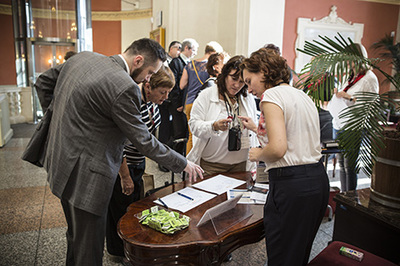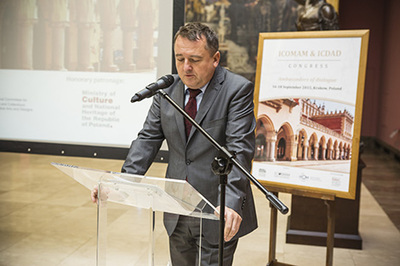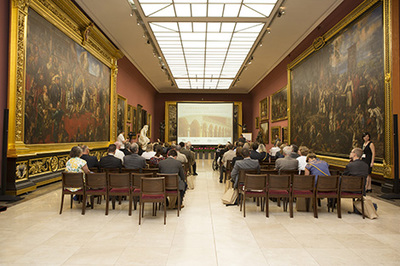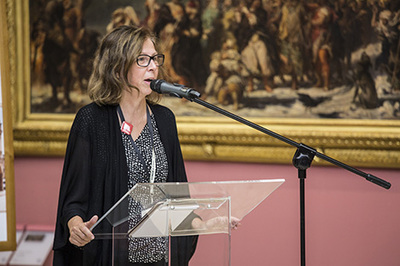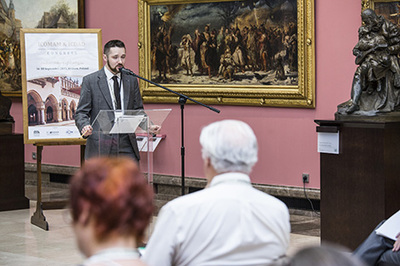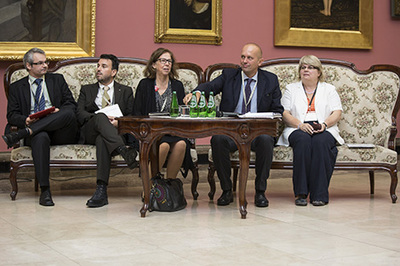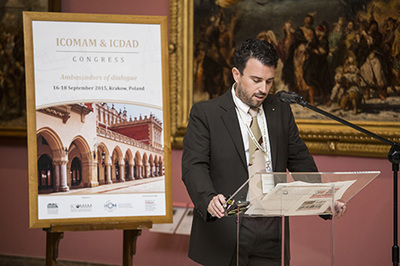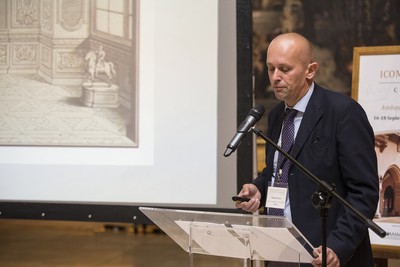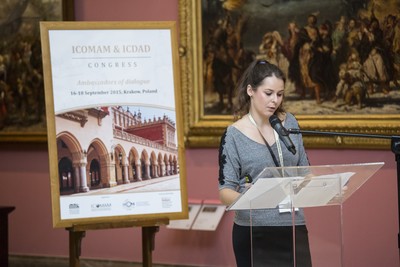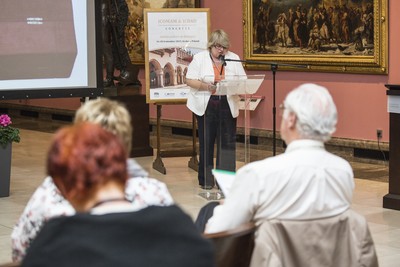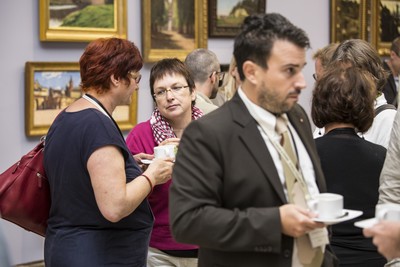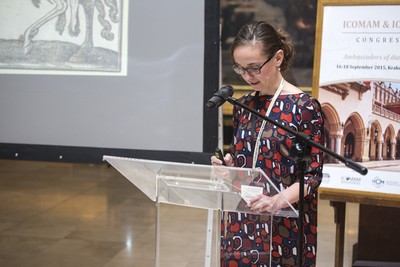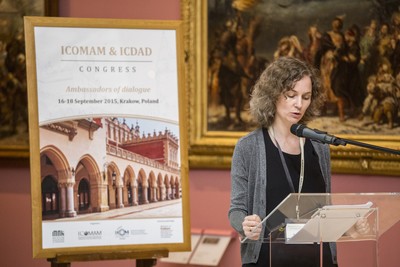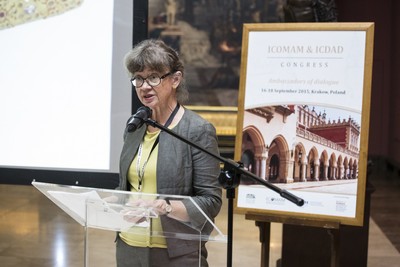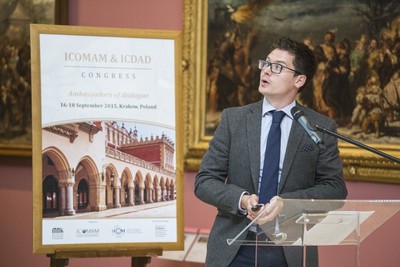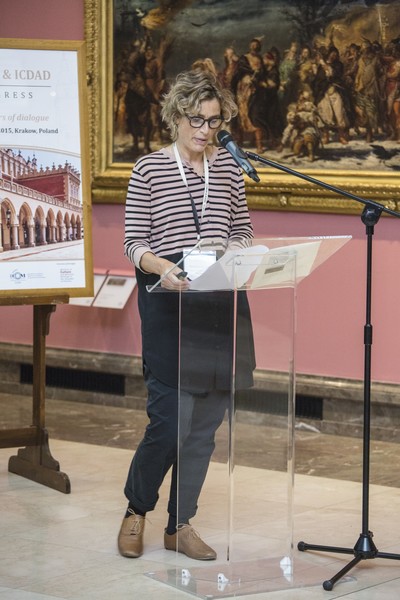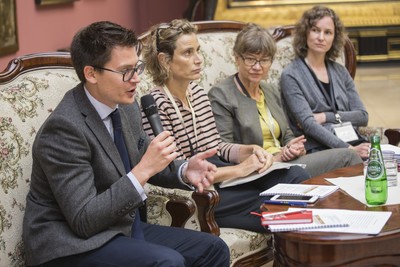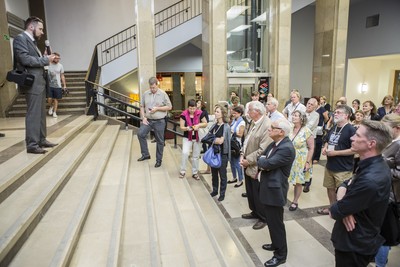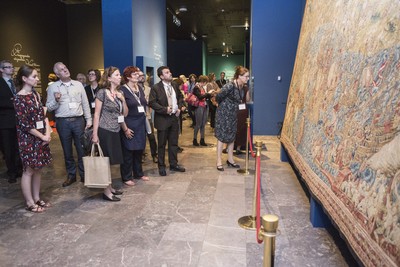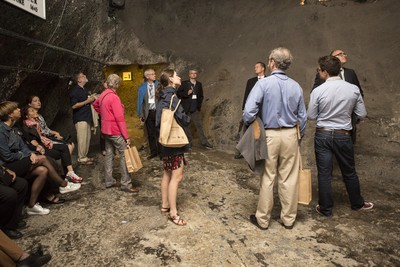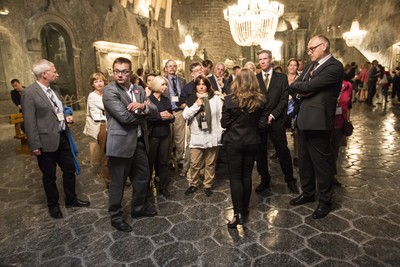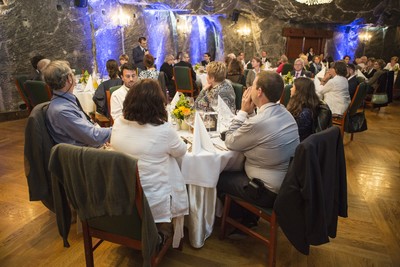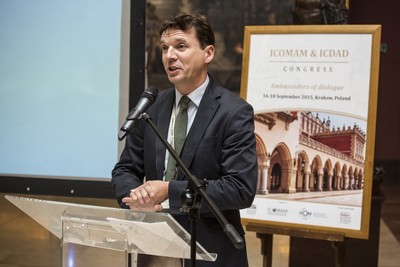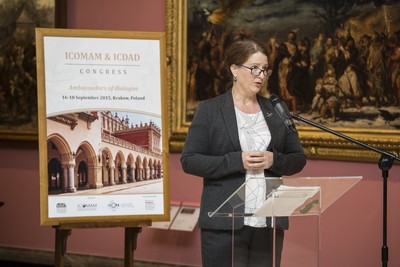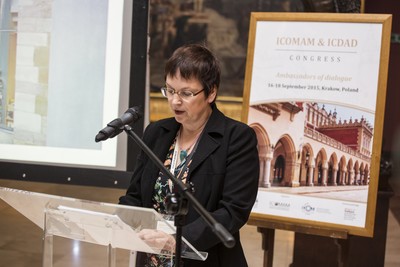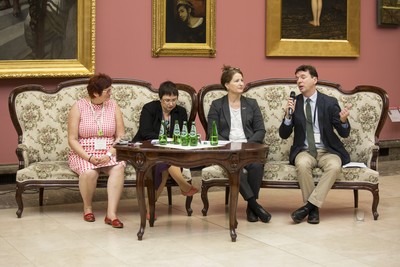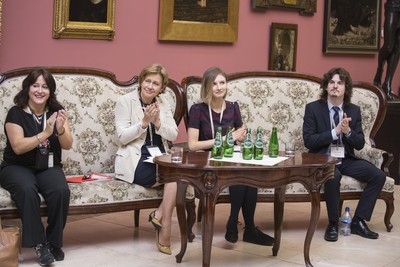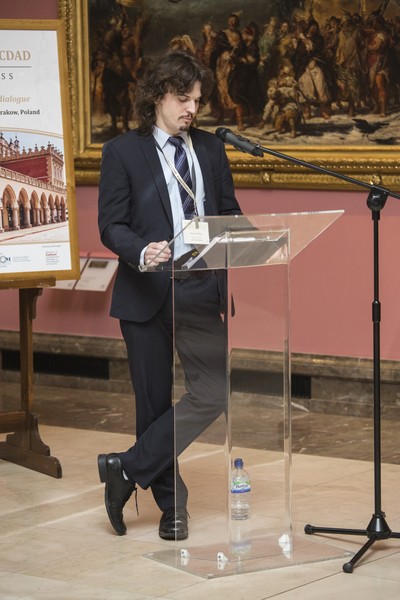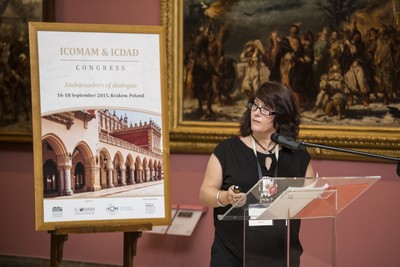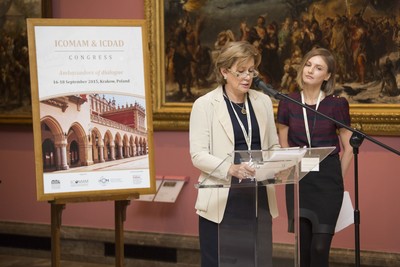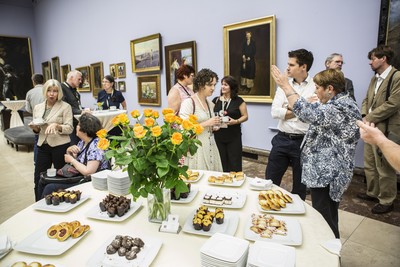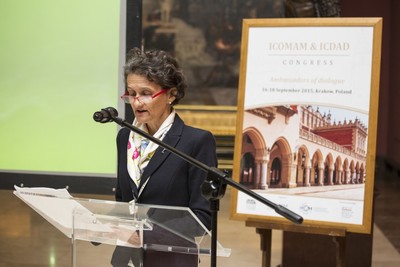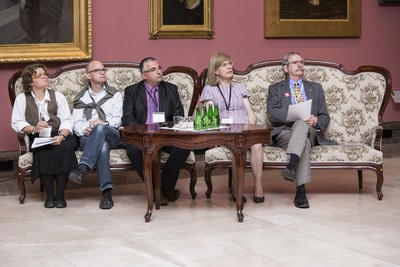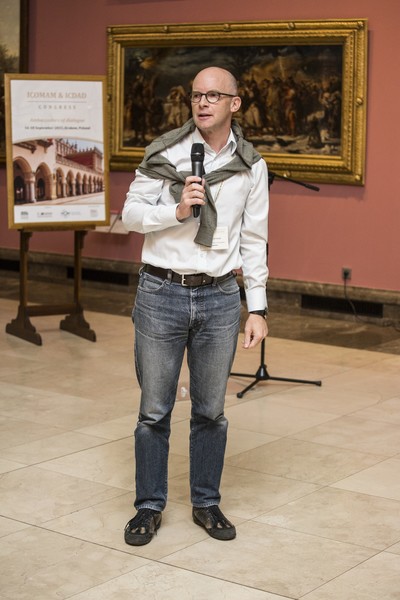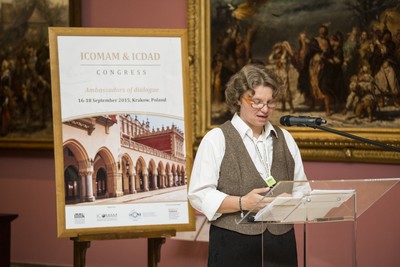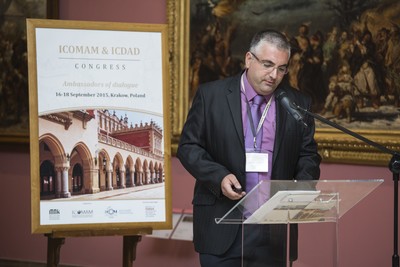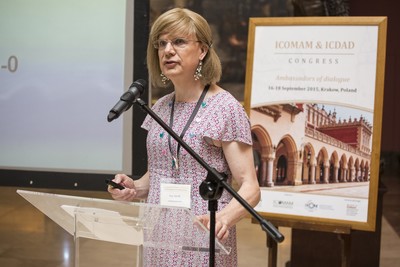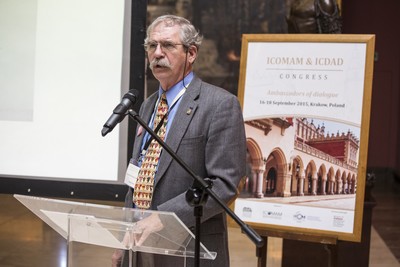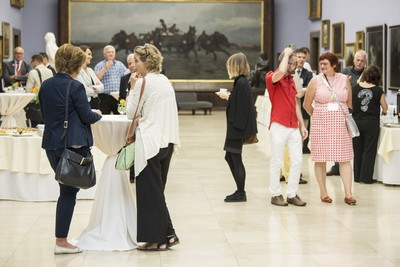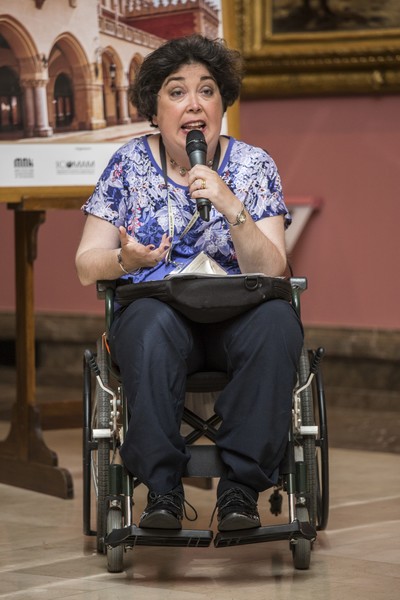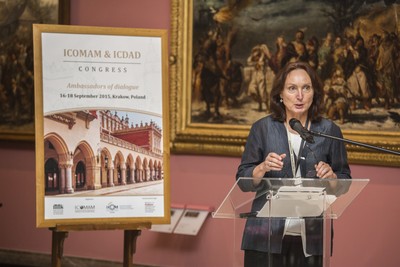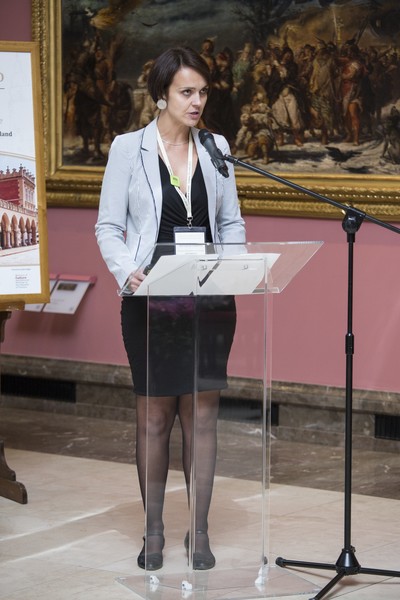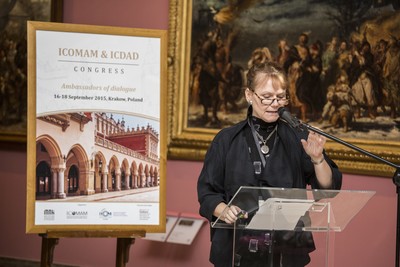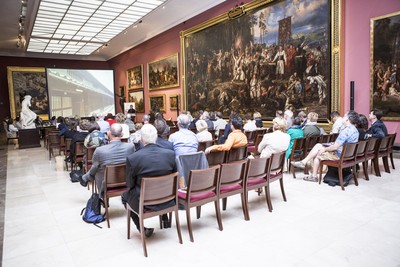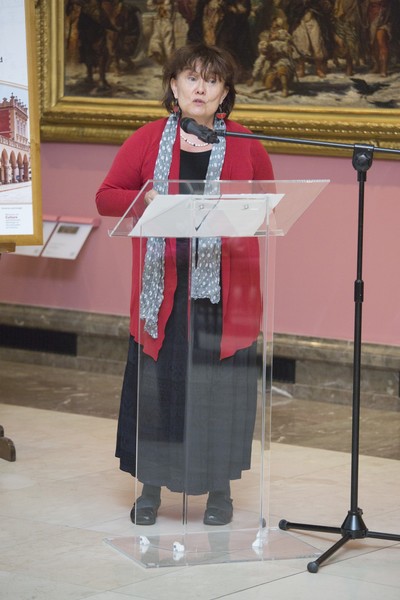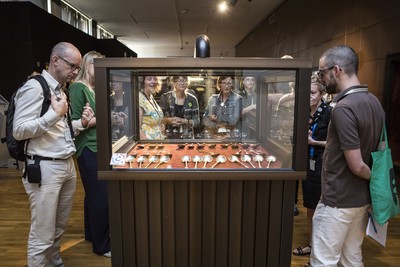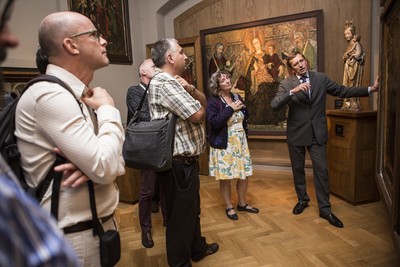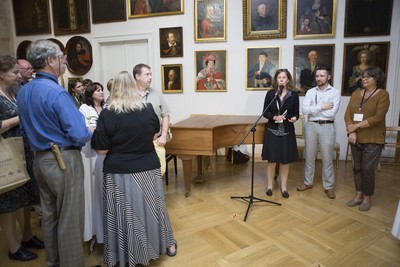Contents
Report
The annual conference 2015 was a joint venture of ICDAD and ICOMAM, the International Committee for Museums of Arms and Military History.
The ICOMAM-ICDAD Congress in 2015 was held in Krakow and Warsaw, Poland, on 15th-20th September 2015. For the first time in history ICOMAM and ICDAD met and worked together. This was also the first congress of ICOMAM organized in Poland, from the time when IAMAM visited the country nearly 40 years ago in 1978, and the first ICDAD meeting in Poland since 1993.
The combined congress of ICOMAM and ICDAD took place in the former capital of the Kingdom of Poland, Krakow, a city of more than 1000 years of tradition, which in the Renaissance played an important role in the culture and politics of the region, being located at the crossroads of culture of Italy, Germany and Oriental influences flowing in from Turkey and Persia. The selection of Krakow was not accidental. In this historic town some of the most interesting collections of old weapons, uniforms and decorative arts in Poland are located. It is also here where is the cradle of modern Polish museums and museology.
The conference was held under the title "Ambassadors of Dialogue" and discussed the role of diplomatic gifts, works of arts and crafts and other artifacts in intercultural exchange.
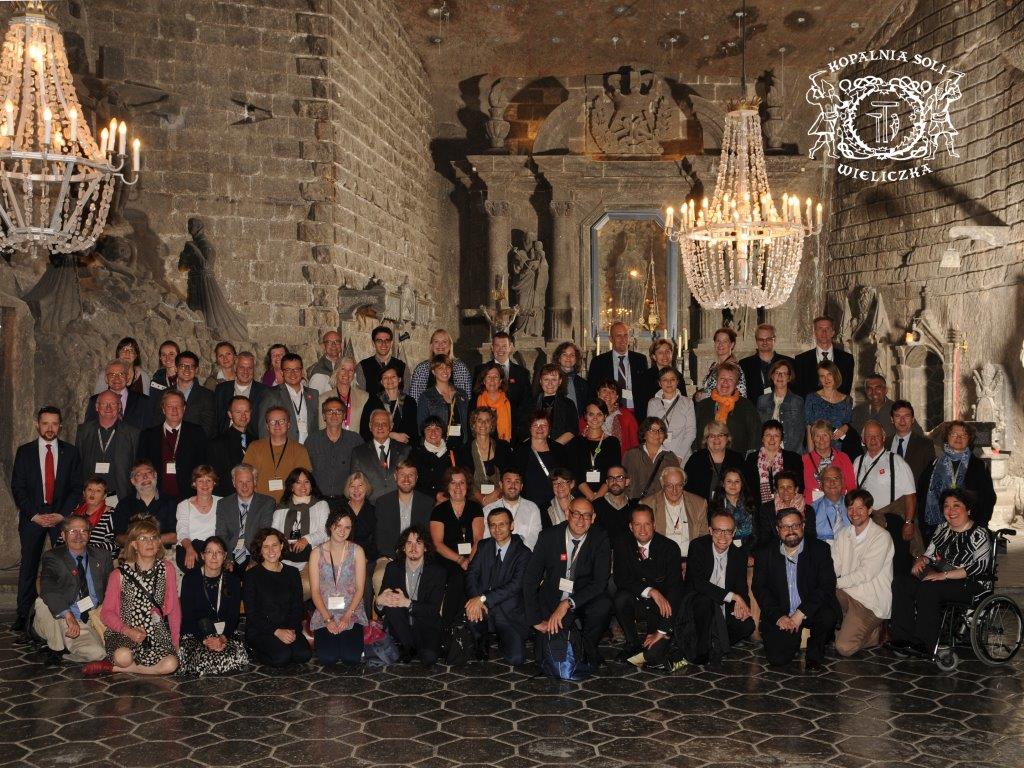
Programme
Wednesday, 16 September 2015
The Cloth Hall at The Main Market Square
| 09.00-09.40 | Registration |
| 09.40-10.05 | Greetings |
| 10.00-14.00 | City sighseeing of Krakow for the accompanying persons |
| 10.05-11.30 | Panel 1. Diplomatic Gifts and Museums |
| 10.05-10.20 | Christoph Hatschek (Military History Museum, Vienna): The Blessing and curse of (military) diplomatic gifts |
| 10.20-10.35 | Jarosław Godlewski (Polish Army Museum in Warsaw): Diplomatic gifts from the era of the Polish-Lithuanian Commonwealth in the collection of the Polish Army Museum |
| 10.35-10.50 | Franz Rainald (MAK, Vienna): Viennese Porcelain as a diplomatic gift |
| 10.50-11.05 | Daria Vinogradova & Elena Porodina (The Central Museum of Armed Forces of the Russian Federation, Moscow): Weapons as Ambassadorial Gifts In the Collection of the Central Museum of Armed Forces of the Russian Federation |
| 11.05-11.20 | Izabela Prokopczuk-Runowska (Polish Army Museum, Warsaw): Gifts of Friendship or reef coral in the collection of the Polish Army Museum in Warsaw |
| 11.20-11.30 | Discussion |
| 11.30-12.00 | Coffee break |
| 12.00-13.50 | Panel 2. Europe and the East |
| 12.00-12.15 | Robyn Dora Radway (Princeton University): Misunderstanding Ottoman Europe Material Culture of the Borderlands in Renaissance Depictions of the Ottoman World |
| 12.15-12.30 | Barbara Karl (MAK, Vienna): Ottoman textiles in the context of diplomatic and courtly gift giving in Vienna |
| 12.30-12.45 | Ann Grönhammar (Livrustkammaren, Stockholm): Diplomatic gifts for Swedish Sovereigns from Safavid Persia and two European vassal states of Ottoman Turkey in the 17th Century |
| 12.45-12.55 | Discussion |
| 12.55-13.10 | Peter Johnston (National Army Museum, London): Gifts From the Frontiers of Empire |
| 13.10-13.25 | Maria José Tavares (Palacio Nacional da Ajuda): A Diplomatic Gift from Japan and the creation of the Chinese Room in Palacio Nacional da Ajuda |
| 13.25-13.40 | Saif Albedwawi (UAE Military Museum): Kuria Muria Islands as symbolic of good relation between Britain and Oman 1854-1967 |
| 13.40-13.50 | Discussion |
| 13.50-14.45 | Lunch |
| 14.45-15.15 | Walk to the National Museum Main Building |
| 15.15-16.30 | Visiting "Ottomania" exhibition |
| 16.30-18.00 | Free time |
| 18.00-18.10 | Meeting point at National Museum Main Bulding - transport to Wieliczka |
| 19.00-20.00 | Visiting Wieliczka Salt Mine |
| 20.00-23.00 | Welcome Dinner in the Wieliczka Salt Mine |
| 23.00-23.30 | Transfer to Krakow / National Museum Main Building |
Thursday, 17 September 2015
The Cloth Hall at The Main Market Square
| 08.30-10.25 | Panel 3. Interpretation and Exchange between the Cultures |
| 08.30-08.45 | Allan Stuart (National Museums Scotland, Edinburgh): Re-capturing the British imperial past |
| 08.45-09.00 | Karin Tetteris (Armémuseum, Stockholm): An image of "the other" - How a 17th century Russian flag was interpreted by the Swedish victors |
| 09.00-09.15 | Petra Krutisch (Germanisches Nationalmuseum): Between Pride and Suspicion. Lothar Franz von Sch&uouml;nborn and the Lohr Mirror Manfacture ca 1700 |
| 09.15-09.25 | Discussion |
| 09.25-09.40 | Henry Yallop (Royal Armouries, Leeds): Swords of Empire: The 19th century Frenchification of European Edged Weapons |
| 09.40-09.55 | Ilse Bogarts (Royal Museum of the Armed Forces and Military History, Brussels) The effects of gifts, 100 years acquisition policy in the Royal Army Museum |
| 09.55-10.10 | Elena Titova (All-Russian Museum of Decorative Art, Moscow): Diplomatic and Cultural Dialogue via Objects |
| 10.10-10.25 | Discussion |
| 10.25-11.00 | Coffee break |
| 11.00-12.30 | Panel 4. Case Studies |
| 12.00-12.15 | Martina Pall (Schell-Collection, Graz): An etched iron cabinet from the Schell Collection |
| 11.15-11.30 | Jana Bělová (City of Prague Museum): Fragments of the railings around Saint Ivan's tomb (+ Mayoral chain / Gifts to mayors of Prague - exhibition) |
| 11.30-11.45 | Robert Cassar (Palace Armoury, Valletta, Heritage Malta): The story of a cannon: diplomacy, friendship and gratitude |
| 11.45-12.00 | Kay Douglas Smith (Independent scholar): The iron keys of Riga: Cannon, diplomacy and Tudor policy in the Baltic |
| Kenneth L. Smith-Christmas (U.S. Marine Corps and U.S. Army Museums): The United States Marine Corps' "Mameluke" Sword (18-19 w., case study, arms) |
|
| 12.15-12.30 | Discussion |
| 12.30-13.00 | Coffee break |
| 13.00-14.20 | Panel 5. Presentation of Individual Museums Plans and Projects |
| 13.00-13.10 | Michał Dziewulski (National Museum in Krakow): Tsuba - 700 Japanese Sword Guards in the National Museum in Krakow |
| 13.10-13.20 | Robert Cassar (Palace Armoury, Valletta; Heritage Malta): The Relocation of the Palace Armoury of the Grandmasters |
| 13.20-13.30 | Suzanne Dalewicz-Kitto (Royal Armouries Museum, UK): Model of the battlefield of Waterloo - conservation project |
| 13.30-13.40 | Eva Czernis-Ryl (Museum of Applied Arts & Sciences, Sydney): A Fine Possession - Jewellery and Identity exhibition: objects, meaning and presentation |
| 13.40-13.50 | Martina Lehmannová (Museum of Decorative Arts in Prague): Monographical exhibition of Jaroslav Horejc (1886-1983) |
| 13.50-14.00 | Melissa Rinne (Kyoto National Museum): The Exhibition Of Decorative Arts At The Kyoto National Museum |
| 14.00-14.10 | Anna Ridovics (Hungarian National Museum in Budapest): New results in the research of Hutterite-Haban ceramics in Hungary |
| 14.10-14.20 | Discussion |
| 14.20-15.20 | Lunch |
| 15.20-17.00 | Visiting Krakow Museums: The Jagiellonian University Museum The Home Army Museum |
| 17.30-19.30 | Visiting Krakow Museum: Oskar Schindler's Factory |
| 19.30-20.00 | Transport to the city center |
Friday, 18 September 2015
National Museum Main Building
| 08.00-09.30 | ICDAD an ICOMAM Committees General Assemblies / 2 groups |
| 10.00-12.00 | Behind the scenes - visiting depots and galleries with curators of National Museum |
| 12.00-13.30 | Walk to the "Wierzynek" Restaurant for lunch |
| 14.00-16.30 | Wawel Royal Castle tour |
| 16.30-17.30 | Visting Wawel Royal Cathedral |
| 17.30-18.00 | Walk to the Bishop Erasm Ciołek Palace |
| 18.00-19.00 | Bishop Erasm Ciołek Palace Museum tour |
| 19.00-21.00 | Farewell cocktail |
Saturday, 19 September 2015
Post Conference Tour
| Attractions of Malopolska Region |
Sunday, 20 September 2015
Post Conference Tour
| Cracow Tour - Underground Museum and former Jewish district Kazimierz |
|
| Return to Krakow or departures from Warsaw Airport |
Abstracts
Spoils of war? Military collections and the British empire (1754-1904)
Stuart Allan
National Museum Scotland
Our research into military collections proceeds from inter-disciplinary approaches to military and World Cultures collections at National Museums Scotland. Spoils of War? extends our interest to those non-European collections which remain embedded in the military museum context and which have been preserved in relation to their function in British military culture: the UK's 136 regimental and corps museums, the National Army Museum and the National Museum of the Royal Navy. The imperial nature of British military service in the last three centuries means these collections retain a material culture record of service in campaigns and garrisons across the globe, which document a range of encounters between British forces and a number of non-European cultures.
In non-military contexts, the phenomenon of collecting in the theatre of war carries a potential stigma, in particular due to associations with looting. The status of 'loot' is often assumed but our work to date indicates that the practice is more complex. Military collections include pieces that were gifted, legitimately bought in markets, or acquired individually as souvenirs and trophies.
Military collecting, and the function of non-European objects in military cultures, is a subject which has not been tackled systematically, nor placed in the context of other forms of imperial collecting. The project offers benefits for our understanding of our own collections, and for knowledge and interpretation of collections in military museums - as confirmed by their participation and feedback to date. There is also clear exhibition potential.
Progress to date and methodology
Two pilot projects have been completed, based on small research grants awarded in 2013 by the Royal Society of Edinburgh and by the British Academy/Leverhulme plus further partnership funding from the National Army Museum (in total £20K). In the former, a series of workshops brought together senior academics and curators from the fields of military historian and anthropology, as well as surveying regimental and corps museum collections primarily in London and Scotland. The second pilot entailed dedicated survey of two campaigns - in Tibet (1904) and in Northeast USA (1756-63), confirming the 'campaign' approach as the most fruitful and manageable in intellectual and practical terms.
We have identified a clear gap in the literature, including questions as to the nature and shape of military collecting; its history; the comparative European context; the change in practices of looting; recent and current practices of military collecting; the personal practice of soldiers in the creation of memorials and souvenirs; the use of objects as decoration in the military interior, and the modification of objects brought back from war. We are now investigating publication of an edited collection based on these pilot projects as a preliminary and context for further research.
Future research grant submission
We are now preparing a funding proposal for a larger project to conduct deeper investigation of six imperial military campaigns which can be understood according to different material perspectives from either side of the conflict encounter. These campaigns are being selected based on our work to date, to be characterised by defining elements of (a) pushing back a frontier (b) retribution, and (c) conceptions of what were thought of as warrior peoples.
With the Principal Investigator and Co-Investigator at National Museums Scotland, we anticipate collaboration from one further academic Co-Investigator based on participation thus far, and continuing project partnership with the National Army Museum. We are exploring the most advantageous project proposal through discussion with the universities and partners in March. (Henrietta Lidchi / Stuart Allan 20/02/2015)
The tomb bar from the Spanish Ambassador to St. Ivan
Jana Bělová
City of Prague Museum, Prague, Czech Republic
St. Ivan, Benedictine monk and hermit, lived in the 9th century. He is the Saint in the Orthodox Church. In the Catholic Church his reverence is limited to the former Benedictine monastery and place of pilgrimage in St. John the Baptist under the Rock between Prague and Beroun. In the period of the Emperor Rudolf II. and during 17th and 18th century was the St. Ivan very popular. In 1600 there was William a San Clemente the Spanish Ambassador at the Court of Rudolf II. He donated to the tomb of St. Ivan a decorative bar. The surviving parts of the bar are in the collections of the City of Prague Museum and the Museum of decorative arts. Around her identification were found several interesting facts.
The story of a cannon: diplomacy, friendship and gratitude
Robert Cassar
Curator, Palace Armoury, Heritage Malta, Valletta, Malta
Amongst the vast collection of weapons and armour of the Order of St John, which is now displayed at the Palace Armoury in Valletta, is a massive bronze cannon with an intriguing provenance. This paper examines its arrival in early 17th century Malta as a diplomatic gift.
The highly ornate cannon was once the centrepiece of the Gießen armoury then owned by Landgrave Ludwig V von Hessen-Darmstadt. In a twist of fate, when the Lutheran King Ludwig V visited Malta while on his way to the Holy Land he befriended Alof de Wignacourt, the Catholic Grandmaster of the Order, to whom he later sent this precious memento as a token of gratitude to his host.
The Relocation of the Palace Armoury of the Grandmasters
The Palace Armoury in Valletta is to return to its original location on the piano nobile in 2017 to remedy the transfer of 1974 which reduced its footprint and compromised the artefacts.
A Fine Possession - Jewellery and Identity exhibition: objects, meaning and presentation
Eva Czernis-Ryl
Curator, Museum of Applied Arts & Sciences, Sydney
A fine possession: jewellery and identity is a major long-term exhibition of 700 objects, which demonstrates that by using unconventional perspectives and unexpected object groupings that can be explored in a stimulating gallery environment, curators and designers can challenge preconceptions, enable new ways of seeing and enhance visitor engagement.
Showcasing jewellery made, worn and collected in Australia, it explores jewellery as a universal communication device across time, place and culture.
Key messages are:
- why we wear jewellery
- how people express identity, individuality and creativity through designing, making, wearing and collecting jewellery
Selected object delight and intrigue with individual stories but also carry the grand stories of culture and civilisation - of religion and tradition, love and death, discovery and colonisation, science, technology and design and other imperatives that govern life.
There are nine themes: Belief & Magic, Love & Death, Nature & Culture, Style & Revival, Gold & Identity, Wealth & Status, Men & Adornment, Modernity & Change and Evolution & Revolution (contemporary jewellery). The thematic structure enables the exploration of meanings of jewellery within different cultures and time periods without being restricted by chronology. While delving into different cultural practices, visitors are invited to discover shared ideas, values and humanity.
Model of the battlefield of Waterloo - conservation project
Suzanne Dalewicz-Kitto
Royal Armouries Museum, United Kingdom
2015 marks the bicentenary of the battle of Waterloo, which saw the defeat of Napoleon by British and Allied forces on 18 June 1815. To commemorate the bicentenary the Royal Armouries is undertaking a series of events including seminars, an exhibition and redisplay of collections related to the battle. As part of this programme a large, complex and historically important model of the battlefield of Waterloo, made by Captain William Siborne in 1842-1843, was dismantled, conserved, reassembled and redisplayed.
This project is unique firstly because of the models size, (approximately 5.5 x 2.2metres) and also that Siborne interviewed veterans of Waterloo to help him recreate this snapshot from the battle. In addition, the project involved a number of logistical challenges related to movement, storage and casing.
It was decided to carry out the work with a high level of public engagement as the subject of a Conservation Live! Programme, i.e at certain times the conservator gave a talk to the public on its conservation and they could observe her working.
Viennese Porcelain as a diplomatic gift
Rainald Franz
Curator, Glass and Ceramics Collection, MAK, Vienna, Austria
Ever since the founding of the Viennese Porcelain Manufacture in 1718, the second oldest in Europe, until its closing in 1864, the Habsburgs have used the products of the private manufacture, which in 1744 was bought by Maria Theresia and since then was led as a state manufacture, as diplomatic gifts. Porcelain was a luxury good very suitable as diplomatic gift to express power, generosity and taste.
The lecture is based on the preparations for the exhibition due to be held on the occasion of the 300th anniversary of the founding of the Viennese Porcelain Manufacture due to be held at the MAK, Vienna, which keeps the bequest of the Porcelain Manufacture, taken over after its closing.
The lecture will exemplify porcelains for Tsarina Catharina, the Duke of Wellington, and other sovereigns, analyzing their aesthetic and diplomatic role as "ambassadors".
Diplomatic gifts of the Polish-Lithuanian Commonwealth in the collection of the Polish Army Museum
Jarosław Godlewski
Polish Army Museum, Warsaw, Poland
The presentation is divided into three subtopics preceded by a brief review of the organisation of diplomatic missions in the Polish-Lithuanian Commonwealth between mid-1500s and the end of the 18th century. First, gifts presented by envoys to monarchs will be discussed, using the example of a sabre presented to King Stanisław Poniatowski by an emissary of Sultan Selim III. The second group are gifts offered by envoys to high-ranking state officials. Here, the blade of a Persian sword offered by the Persian embassy to Jan Zamoyski, will serve as an example. The last group comprises informal gifts and presents which were to win the favour of state officials or representatives of great magnate families.
Diplomatic gifts for Swedish Sovereigns from the Crimea and Persia in the 17th Century
Ann Grönhammar
Livrustkammaren, Stockholm, Sweden
In certain respects there seem to have been easier to communicate between Sweden and countries east of the European borders in the 17th century than today, at least if judging from not very few preserved diplomatic gifts in the Royal Armoury in Stockholm. In the museums storage rooms hide shimmering saddles, bows and quivers decorated with turquises and peridotes as well as sabres end daggers inscribed with arabic letters - as fetched from treasures of the Arabian Nights. Their true stories give life to a past filed of ambitions for political and military power through alliances as well as fortunes from trade. My paper will deal with some of these items, their givers and receivers and the historical contexts.
Blessing and curse of military diplomatic gifts
Christoph Hatschek
Heeresgeschichtliches Museum, Militärhistorisches Institut, Vienna, Austria
Finding the accurate and at least perfect gift for friends and relatives often seems to be an extremely difficult task. However even more difficult it seems to find the finally corresponding honourable gift for official visits abroad - as specially this regards military-personal. The quite comprehensive portfolio ranges here from tasteful, selected with personal reference, typical and ultimately also symbolic up to pure kitsch products. The Military History Museum in Vienna was and is not only giving advice on the selection of appropriate diplomatic gifts during the last decades but also was confronted more and more with an increasingly acquisition of those which had been received by the Austrian Armed Forces. Together with the Ministry of Defence and Sports finally a workable solution was ultimately prescribed pursuing even charitable purposes.
Encounters and Gift Giving at the Frontiers of Empire
Peter Johnston
National Army Museum, London
In the 19th and 20th centuries, the British Army was a driving force of Empire, being used to conquer and police new territories across the globe. The men who marched with the colours were soldiers, but also explorers, surveyors and diplomats. They were amongst the first British men to encounter the native peoples of the lands they were seeking to subjugate, and drove the first encounters through fire and flame. Gift giving took resulted, either to placate the conquerors or to rebuild relationships with a subjugated population.
This paper will highlight some of those items from the Collection of the National Army Museum, ranging from as far afield as India, North America and New Zealand. They introduced the British to new craftsmanship and cultures, and are part of our treasured Collection.
Ottoman textiles in the context of diplomatic and courtly gift giving in Vienna
Barbara Karl
Curator, Textile Collection, MAK, Vienna, Austria
The Ottoman and Habsburg Empires shared a border region for several centuries starting in the sixteenth century. Inimical encounters apart, diplomatic contacts between the two powers occurred on various levels and exchanged valuable gifts. Ottoman objects were not only presented by Ottoman emissaries but circulated within the networks of courtly gift giving. The presentation focuses on the second half of the 16th century; the object focus will be textiles. Questions regarding the reception and circulation of these objects and changing perceptions will be addressed.
Between Pride and Mistrust. Lothar Franz von Schönborn and the Lohr Mirror Manufacture ca 1700
Petra Krutisch
Germanisches Nationalmuseum
In the year 1701, two large wall mirrors and items of mirrored furniture arrived at the imperial court in Vienna. They were a gift of the Archbishop-Elector of Mainz, Lothar Franz von Schönborn (1655-1729), who had commissioned them from the mirror manufacture he had established in 1698 in Lohr, near Würzburg. With this shipment, he demonstrated - not without a certain pride - the superb quality and, above all, the large scale of the products of the manufactory. On the other hand, Lothar Franz had only recently denied the written request of Emperor Leopold I (1640-1705) for express approval of a tour of the manufacture by an Austrian envoy. Between these two apparently contradictory actions lie interesting motivations, which will be investigated.
Monographical exhibition of Jaroslav Horejc (1886-1983)
Martina Lehmannová
Museum of Decorative Arts in Prague
Jaroslav Horejc (1886-1983) was one of the most important designer (glass, ceramic, jewellery etc.) of the 1st half of 20th century in former Czechoslovakia. Mostly admired are glass beakers, which were often used as gifts for political representatives.
The City of Prague Gallery and Museum of Decorative Arts in Prague are now preparing a monographical exhibition for 2016.
An etched iron cabinet from the Schell Collection
Martina Pall
Schell-Collection, Graz, Austria
Gifts as a form of diplomacy have always been an effective means of making oneself appear generous, knowledgeable and worldly in the eyes of the host.
The iron cabinet in the Schell Collection, is exemplified by the outstanding etchings, which (with the exception of the floor) can be seen on all sides of the cabinet, as well as on the inside of the 13 drawers.
It quickly became clear that the templates had to be from Virgil Solis. The inimitable style of the perhaps most famous engraver of his time, is particularly evident in the representation of the 7 liberal arts and here in the representation of "waving scarves and veils" that surround the female figures.
Identification was made by way of the two coats of arms on the top of the cabinet.
On the left, the coat of arms of Erich I, Duke of Braunschweig-Kalenberg (1470-1540) and on the right, those of his second wife, Elizabeth of Brandenburg. The marriage was celebrated in 1525 and for a long time it seemed quite clear that the wedding had to be the reason for the significant gift.
The lecture is concerned with the templates for the etchings and the identity of the person who presented the unique iron cabinet as a gift.
Weapons as Award or Commemorative Gift in the Collection of the Central Museum of Armed Forces of the Russian Federation)
Elena Porodina, Daria Vinogradova
Central Museum of Armed Forces, Moscow
Gift is an object passed as a special donation. Its semantic function is multifaceted. A gift can express a positive assessment and respect for the man and his work; become a symbol of the establishment, maintenance or development of relations, as well as an expression of solidarity and mutual assistance among individuals and even between nations and states.
The tradition of offering ambassadorial gifts exists for many centuries, and over time it is getting intercultural unification.
Weapons as a subject of donation can have several meanings. For example:
- Diplomatic or state gift;
- Award.
Rather often a weapon as the subject of gift shows with itself an example of arts and crafts, which gives it a special uniqueness and wealth.
The Central Museum of Armed Forces of the Russian Federation owns a large collection of such items - gifts. It consists of premium and deluxe weapons that symbolized awards or commemorative gifts and belonged to the famous Soviet generals and statesmen. By the number it is quite a large collection and it gives us the ability to create large-scaled exhibition projects to demonstrate such objects with a significant amount. "Weapons as Award and Commemorative Gift" Exhibition has been repeatedly showed with great success in various regional museums in Russia.
Weapon as a Commemorative Gift: such as a pair of the "Colt" pistols. It was presented to Leonid Brezhnev who led the USSR and its Communist Party by Gerald R. Ford the US President. In November 1974 they met in Vladivostok for bilateral summit. Pistols are decorated with images to symbolize the Soviet Union and the United States. Gold and ivory plates are fixed on the Colts bodies and handles.
Weapon as an award: such as "Mauzer" pistol - an Honorary Revolutionary Weapon. Semen Budenny who was a famous soviet military commander during the Civil War period in Russia got this special award in 1921. This "Mauzer" is a very rear sample and it is decorated with the Order of the Red Banner sing.
Such a perspective on weapons helps to draw an attention to it, firstly, as a museum object, secondly, as a symbol of diplomatic relations, thirdly, as an item to characterize mission of state and military leaders and finally, the last but not least, as a work of art.
Gifts of friendship or coral in the collection of the Polish Army Museum in Warsaw
Izabela Prokopczuk-Junowska
Polish Army Museum, Warsaw, Poland
Throughout history, exchange of gifts has served to manifest good international relations. The PAM collection boasts a number of gifts of friendship, such as collections of uniforms, badges and decorations offered by communist regimes (including Mongolia, North Korea and Vietnam) in the 1960s. Tokens of friendship presented to the Polish People's Republic by the USSR include a 17th-century half-kartouwe and a Polish artillery officer's uniform jacket dated between 1789 and 1794, while a coral and a 2-metre long Chinese cloth depicting the construction of a bridge are among gifts received by state institutions on various official visits and later donated to the Museum. Gifts of friendship continue to enrich the collection of the PAM. Most of them are in the form of plaques, though this custom seems to be undergoing change: this year, the PAM presented Estonia with a T-34/85 tank and received a Centurion MK V tank from the Kingdom of the Netherlands.
Misunderstanding Ottoman Europe Material Culture of the Borderlands in Renaissance Depictions of the Ottoman World
Robyn Radway
Princeton University
Pieter Coecke van Aelst's 1553 Customs and Fashions of the Turks is just one of many Renaissance artworks to include a curious turbaned figure carrying a curved trapezoidal shield sprouting feathers. This presentation seeks to examine how this and other contemporary works of art came to identify this Central European shield with the Ottoman military by highlighting three historical moments that contributed their own distortions to the (mis)understanding of material objects and their representation. It shows how artist and audience, text and image, museum object and description all struggle with drawing boundary markers where they do not exist in the overlapping borderlands of Ottoman Europe.
New results in the research of Hutterite-Haban ceramics in Hungary
Anna Ridovics
Hungarian National Museum in Budapest
Production technology of tin-glazed earthenware, faience in 16-17th century Eastern-Central Europe was mostly disseminated by German speaking Hutterite Anabaptist potters, migrating through different countries because of their religious belief. They brought their skills and implanted a local pottery production under the influence of their new artistic language. The aim of our consortial project with the participation of the Hungarian National Museum, Museum of Applied Arts, Ethnographical Museum and Institute for Geochemical Research is to prepare database of Hutterite-Haban ceramics in Hungary. Arthistorian, ethnographer, archaelogist, conservator, potter and natural scientist are working together. We are applying historical research and stilistical interpretation together with archeometrical methods. Investigations are performed on ceramics from museum and private collections as well as on archaeological artefacts - among them artefacts from the excavations of Anabaptist settlement in Sárospatak-Héce. Hutterite-Haban ceramic thesaurus in Hungary is analysed comparing with similar collections of surrounding countries. Archaeometric research on Haban faience using modern analytical techniques focuses on the mineralogical, petrographic and geochemical investigation of the ceramic body, the tin-opacified glaze and the decorations of different colours, and aims to identify the used raw materials and to reconstruct the production technology.
The Exhibition of Decorative Arts at the Kyoto National Museum
Melissa Rinne
Fellow for International Museum Affairs, Kyoto National Museum
This short presentation will introduce the general policies for the display of decorative arts (textiles, lacquer, metalwork, and ceramics) in the Kyoto National Museum's new Heisei Chishinkan Wing, designed by Taniguchi Yoshio. The practices of display in Japanese museums differ greatly from those in most museums in the West in many ways: exhibitions are changed with surprising frequency and many of the works on view in permanent collection exhibitions are not actually owned by the museum.
These sorts of issues will be briefly outlined and explained in a five-minute Powerpoint presentation. Kyoto is a candidate for the host city of the 2019 ICOM General Conference.
The iron keys of Riga: Cannon, diplomacy and Tudor policy in the Baltic
Kay Smith
Independent scholar
In the 1570s, the city of Riga was under threat from the growing power of the state of Muscovy. They applied to Queen Elizabeth of England to be allowed to export cast-iron cannon from England for their defence. As a diplomatic favour the Queen allowed the export in exchange for a 'gift' of grain. One of these cannon survives, unrecognised, in a major European collection and this paper will discuss Queen Elizabeth's use of cannon export licences to the the Baltic regions as part of Tudor diplomacy in a wider sphere.
The U.S. Marine Corps' Mameluke Sword
Kenneth Lee Smith-Christmas
Retired Museum Curator and Director, US Marine Corps and US Army Museums, and ICOMAM Board Member
Officers of the United States Marine Corps today proudly carry a sword that dates back to the early 19th Century, and is patterned after the distinctive saber carried by the Egyptian Mameluke cavalry of the Ottoman Empire. Aside from a brief hiatus from 1859 to 1875, generations of Marine officers have worn the "Mameluke" sword. Although not carried into battle since the early 20th Century, there are notable instances of its earlier use in combat. While similar to other swords carried by officers of several nations it is nearly unique as probably the only example of Ottoman influence on edged weapons in American military formations. This ten-minute power point presentation will include art and photographs of noteworthy USMC Mameluke swords.
A Diplomatic Gift from Japan and the creation of the Chinese Room in Palacio Nacional da Ajuda
Maria José Tavares
Furniture Curator, Palacio Nacional da Ajuda
The Palacio Nacional da Ajuda in Lisbon was the royal residence from 1861 until the end of Monarchy in 1910. Its decorative interiors are according to the second half of 19th century standards and taste: eclectic and romantic pieces decorate the new variety of rooms.
In 1865 a room was created with the propose to accommodate the diplomatic gift sent from the Taikun of Japan to the King of Portugal. A room in Oriental Pavillion style.
These beautiful presents - lacquer shelves, porcelain jars and others - are the remains of the beginning of the diplomatic relations between Portugal and Japan after the signature of the Treaty of Peace, Friendship and Commerce between the two countries in 1860, and the Japanese Embassy to Europe in 1862 which held negotiations in Portugal among other countries …
Diplomatic and Cultural History via Objects
Elena Titova
Director, All-Russian Museum of Decorative Art
The paper will start with a brief introduction of the All-Russian Museum of Decorative Art, its history and perspective programmes. Museum collections cover Russian decorative, applied and folk art of the 17th - 20th cc. The museum in undergoing significant transformations scheduled up to 2018, which aim towards wider publicity and actualization of versatile museum collections. Development plan includes venues expansion and renovation, total redisplaying of museum items, their updated interpretation.
The process of opening up the museum's funds, of developing educational programs for different social groups and communities, of expanding the permanent and temporary displays requires complicated research and new approaches. The aspects of museum objects and general context they consider are getting important for better understanding of national and international history, cultural and social links, communication, cultural and art phenomena.
For this congress there is a presentation of some key items from Decorative Art museum collections which were in various ways involved in the process of intercultural exchange over the ages.
I. Official gifts. This group includes various sorts of items executed in diverse techniques and related to a broad time span of 17th - 20th centuries. A few categories can be distinguished within this major group.
Firstly, there are internal (national) official gifts and awards. Tradition of memorable, amicable, honourable gifts is one of the most deeply rooted in Russian culture.
- The earliest piece from this category in the museum's collection is the granted drinking ladle (kovsh), which dates back to the end of the 17th century.
- An exclusive item is an award saber, which once belonged to Sergey Vitte, Prime Minister of Russia in the beginning of 20th century.
- A very peculiar group of items in this category are the commemorative hatchers created in the famous Russian center of artistic metalwork Zlatoust. These were awarded for outstanding labor achievements of the first five-year plan for the development of the national economy of the Soviet Union (1928-1933/4).
Another outstandingly interesting category - international diplomatic gifts for soviet leaders (J. Stalin, N. Khrushev, L. Brezhnev), other high-rank authorities (Minister of culture Yu. Melentiev) and official delegations. These are made in different materials and techniques (glass, textile, ceramics, wood, metal etc.) and represent a broad artistic and qualitative range (from souvenirs to high-grade artworks).
II. Second large group of objects which reflects the main theme of the 2015 ICOMAM/ICDAD conference (intercultural exchange, spread of patterns and ideas between cultures and nations) - is formed by pieces displayed and honoured at international exhibitions in 1900 (Paris), 1925 (Paris), 1937 (Paris), 1939 (New York), 1958 (Brussels).
These pieces represent the prevailing trends in decorative art of each decade, and it is also noteworthy that they were pre-selected as valuable and worthy for international presentation by Russian experts. Both before and after the revolution items for international shows were meticulously selected by the national exhibition committee and by specialists in the field of decorative art. Thus those pieces provide a significant opportunity to reconstruct the ways and channels in which artistic ideas, patterns and techniques spread from Russia in the first half of the 20th century.
The All Russian Museum of Decorative Art holds a unique collection of items previously displayed at international exhibitions - for instance, stone carving pieces executed for the 1937 Paris exhibition by the masters, who previously worked for the Carl Faberge brand.
Museum collections include pieces which are in many ways fundamental for studying intercultural exchange over the last few centuries, but have been unfortunately overlooked by both international and national art historians. The suggested paper will help bring more attention to presented unique collections which have to be considered in the context of international artistic, diplomatic and cultural relations.
Swords of Empire: The 19th century Frenchification of European Edged Weapons
Henry Yallop
Royal Armouries, Leeds, Great Britain
The 19th century saw the standardisation of military edged weapons become commonplace across Europe. However, far from each nation devising their own edged weapons independently, France was the clear leader in terms of developing forms that others followed.
In some cases the reasons for this are clear. French occupation saw allied states adopt French patterns, to fight alongside the French with. The reverse is also true - enemies of France made use of large numbers of captured French weapons with which to equip their own troops to fight against Napoleon.
However, the duration and geographical range of French influence on edged weapon design, particularly military swords, cannot be wholly explained by either of these reasons.
This paper will explore the wide ranging influence of French edged weapon designs, both in time and place, on Western militaries.
Participants
- Stuart Allan, Principal Curator, Scottish Late Modern collections, National Museums Scotland
- Eric Basile
- Florian T. Bayer, Head of collection / Custos, Esterhazy Foundation
- Jana Bělová, Curator, City of Prague Museum
- Staffan Bengtsson, Director-General, The National Swedish Museums of Military History
- Natasha Bennett, Acting Curator of Oriental Collections, Royal Armouries
- Monica Bilfinger, Art historian, Bundesamt für Bauten und Logistik BBL
- Armando Bittencourt, Director, Brazilian Naval Historical Heritage and Documentation Directorate
- Ilse Bogaerts, Curator Collection Uniforms & Equipment, Royal Army Museum Brussels
- Robert Brooker, retired, Landeszeughaus Graz
- Ruth Brown
- Robert Cassar, Curator Palace Armoury, Heritage Malta
- Ewa Czernis-Ryl, Curator, Arts and Design, Museum of Applied Arts and Sciences, Sydney
- Suzanne Dalewicz-Kitto, Conservation Manager, Royal Armouries
- Dimitar Dimitrov, President, Bulgarian Commission of Military History
- Eva-Sofi Ernstell, Director, Army museum, President of ICOMAM
- Rainald Franz, Curator Glass and Ceramics Collection, MAK - Austrian Museum of Applied Arts / Contemporary Arts, Vienna, Austria
- Alfred Geibig, Curator - head of arms & armour department, Kunstsammlungen der Veste Coburg
- Jarosław Godlewski
- Ann Grönhammar, Curator, Royal Armoury
- Agnieszka Grzesiak
- Andreas Gugler, Curator, Bundesmobilienverwaltung, Vienna, Austria
- Lauri Haavisto, Head of Exhibitions, The Military Museum of Finland
- Christoph Hatschek, Vice Director/ Head of Department Collection & Exhibition/ Head of Collection Uniforms, Decorations, Equipment & Flags, Heeresgeschichtliches Museum Militärhistorisches Institut
- Christian Hörack, Conservateur du département des arts appliqués, Musée d'art et d'histoire
- Emilia Jastrzębska, International Cooperation Coordinator, Polish Army Museum
- Peter Johnston, Collections Content Manager, National Army Museum, London
- Maria Jose Tavares, Curator of Furniture Collection, Palacio Nacional da Ajuda
- Barbara Karl, Curator of Textiles and Carpets, MAK - Austrian Museum of Applied Arts / Contemporary Arts, Vienna, Austria
- Helena Koenigsmarková, Director, Museum of Decorative Arts in Prague, President of ICDAD
- Petra Krutisch, Germanisches Nationalmuseum Head of the Furniture Collection
- Elisabeth Lagvik, Director of the Public Unit, Flygvapenmuseum (Swedish Air Force Museum)
- Martina Lehmannová, Curator, The Museum of Decorative Arts in Prague
- Hellar Lill, Director, Estonian War Museum - General Laidoner Museum
- Lasse Mattila, Conservator, Conservation and Museum Services Lasse Lattila Ltd
- Janice Murray, Director General, National Army Museum
- Rosita Nenno, Senior curator / vice director, DLM Deutsches Ledermuseum Schuhmuseum Offenbach
- Torsten Nilsson
- Jan Norrman, Curator, Nationalmuseum, Stockholm, Sweden
- Martina Pall, Director, Hanns Schell Collection, Graz, Austria
- Elena Porodina, Science secretary, Central Museum of Armed Forces of the Russian Federation
- Angelina Pötschner-Franz, Curator of monuments, Bundesdenkmalamt, Vienna
- Izabela Prokopczuk-Runowska, Kurator Działu Zbiorów Glównych, Muzeum Wojska Polskiego
- Aleksandra Radwan
- Robyn Radway, PhD Candidate, Princeton University
- Anna Ridovics, Art historian, Hungarian National Museum
- Melissa Rinne, Research Fellow for International Affairs, Kyoto National Museum
- Hedwig Saam, Director, Nationaal Militair Museum
- Annamarie Sandecki, Archivist / Manager - Archives Tiffany & Co., Tiffany & Co.
- Alexandra Savenkova, International exhibition projects specialist, The All-Russian Museum of Decorative Art
- Liselotte Schell, Hanns Schell Collection, Graz, Austria
- Hanns Schell, Owner, Hanns Schell Collection, Graz, Austria
- Zoe Scott, Manager, Western Australian Museum - Kalgoorlie
- Robert Smith, Retired Independent Scholar
- Kenneth Smith-Christmas, Retired - Former Curator, US Army & US Marine Corps Museums
- Anna Sobesto, National Museum in Krakow
- Josef Sramek, Historian - curator, Museum of Eastern Bohemia in Hradec Králové
- Karin Tetteris, Curator, Armémuseum, Stockholm, Sweden
- Harpa Thorsdottir, Director, Museum of Design and Applied Art, Iceland
- Elena Titova, Director, The All-Russian Decorative Art Museum
- István Tóth
- Paulus Johannes Cornelis Van Brakel, Conservator, Stichting Defensie Musea / Nationaal Militair Museum
- Folou Verlaine
- Daria Vinogradova, Junior Science researcher, Central Museum of Armed Forces of the Russian Federatio
Images
